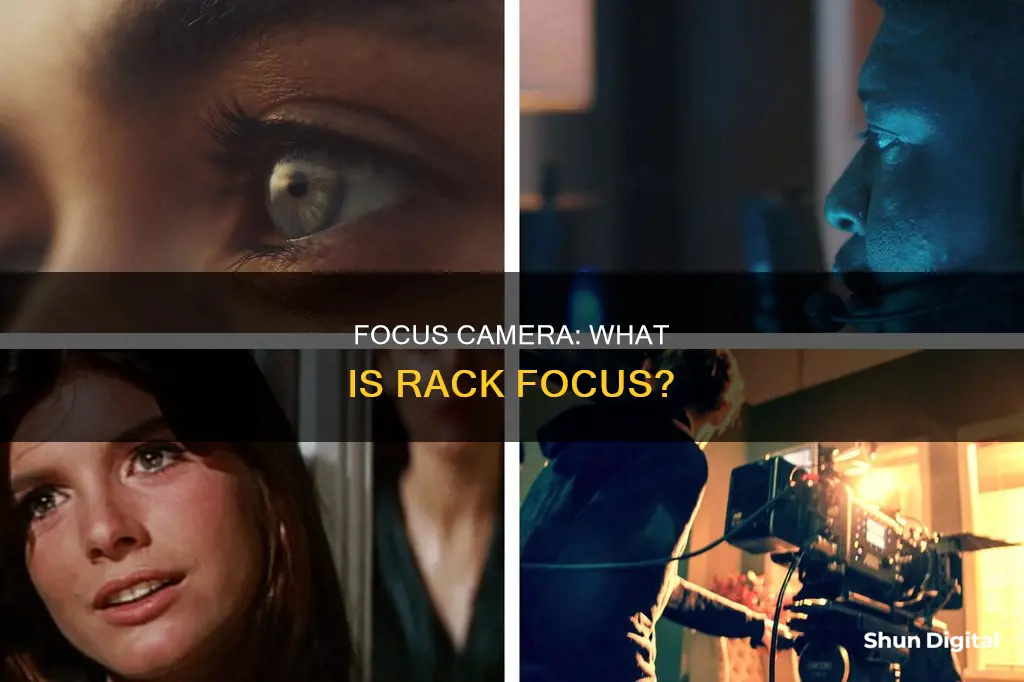
Rack focus is a cinematography technique where the focus of the lens is changed during a continuous shot, shifting the focal plane from one object in the frame to another. Also known as a focus pull or pulling focus, the technique can be used to add drama or direct the audience's attention to a specific detail. It is often used in scenes with dramatic dialogue to add emphasis. The technique requires a lot of practice and finesse and is usually performed by a dedicated focus puller or 1st Assistant Camera (1st AC).
| Characteristics | Values |
|---|---|
| Definition | A filmmaking technique of changing the focus of the lens during a continuous shot. |
| Other Names | Focus pull, pulling focus |
| Purpose | To direct the audience's attention to something in the scene, to transition between scenes, to add dramatic flourish, to follow a character's train of thought, to reveal something hidden in the frame, etc. |
| Who Performs It | The focus puller (usually also the 1st Assistant Camera) works with the Camera Operator to adjust the focus ring during the shot. |
| Equipment | Camera lens with a manual focus ring, follow focus system, tripod |
| Preparation | Determine objects to switch between, decide on the depth of field, measure distances, mark focus ring |
| Speed | Can be controlled for varying effects, e.g., a fast-track focus for excitement vs. a sluggish rack focus for suspense |
| Movement | Can be combined with camera movement (e.g., pans, tilts, dolly moves) for a sophisticated and cinematic effect. |
What You'll Learn
- Rack focus is a technique in filmmaking that uses a shallow depth of field to shift focus during a continuous shot
- It is used to direct the audience's attention, adding dramatic emphasis to a scene
- It can be used to transition between scenes, to follow a character's thoughts, or to reveal hidden details
- A focus puller is a dedicated role on a film set, working alongside the camera operator to execute rack focus shots
- Rack focus is a valuable storytelling tool, helping to build tension and guide the audience's attention without the need for dialogue or physical movement

Rack focus is a technique in filmmaking that uses a shallow depth of field to shift focus during a continuous shot
To achieve rack focus, the focus ring on the lens barrel is turned smoothly and slowly until the desired subject comes into focus. This technique can be used to shift focus between two actors, or from an actor to a prop, for example. It is often used in scenes with dramatic dialogue to add emphasis and shift focus between speakers.
Rack focus is an effective way to guide the audience through a scene, holding their attention and building suspense or tension. It can also be used to reveal hidden details in the frame, transition between scenes, or combine multiple shots into one.
To set up a rack focus shot, a camera lens with a manual focus ring is required. The camera is typically locked down on a tripod to ensure smoothness. The focus puller then adjusts the focus ring to shift the focal plane from one object to another during the continuous shot.
Rack focus is a valuable tool for filmmakers as it allows them to direct the audience's attention and emphasise specific details without cutting away from the scene. It adds an intimate and engaging element to the storytelling.
Focusing on Infinity with Lumix: A Step-by-Step Guide
You may want to see also

It is used to direct the audience's attention, adding dramatic emphasis to a scene
Rack focus is a powerful storytelling tool used in filmmaking to seamlessly shift the audience's attention from one subject to another. It is a subtle yet impactful way to guide viewers through a scene, enhancing the narrative and creating dramatic emphasis without any dialogue.
Rack focus involves changing the focus of the lens during a continuous shot, moving the focal plane from one object to another within the same frame. This technique, also known as "focus pull" or "pulling focus", can include small or large changes in emphasis, with the transition between focal planes being more noticeable when the depth of field is shallower.
By employing rack focus, filmmakers can direct the audience's attention to specific details, characters' reactions, or hidden emotions, thus revealing subtextual elements and enhancing the emotional impact of the scene. For example, in the movie "Road to Perdition", director Sam Mendes uses rack focus to reveal Connor's (played by Daniel Craig) jealousy, rage, and revengeful thoughts towards his father (Paul Newman) and Michael (Tom Hanks). As Rooney and Michael pass Connor, the focus follows them, giving insight into Connor's inner thoughts and adding dramatic emphasis to the scene.
Rack focus can also be used to create tension and suspense, as seen in the movie "The Host", where the focus is pulled back and forth between the main character and their siblings as they attempt to escape from quarantine. Additionally, it can be used to establish relationships between characters, as demonstrated in "Young Victoria", where the rack focus helps to dissect the complex relationships between the characters at a dinner table.
To achieve a successful rack focus shot, filmmakers must pay attention to various factors such as equipment, camera and subject positioning, depth of field, and distance measurements. It is a delicate balancing act that requires precision, timing, and practice to master.
Focus Camera Safety: Is it Secure?
You may want to see also

It can be used to transition between scenes, to follow a character's thoughts, or to reveal hidden details
Rack focus is a filmmaking technique used to change the focus of the lens during a continuous shot. It is also known as a "focus pull" or "pulling focus". The technique can be used to transition between scenes, to follow a character's thoughts, or to reveal hidden details.
When a shot is "racked", the focal plane moves from one object in the frame to another. This can be a small or large change in focus. The more shallow the depth of the field, the more noticeable the transition between focal planes.
In the film "Road to Perdition", director Sam Mendes uses a rack focus to reveal the character Connor's (played by Daniel Craig) thoughts. As Rooney and Michael pass Connor, the focus follows them, indicating Connor's feelings of jealousy, rage, and revenge.
Rack focus can also be used to create tension and suspense. For example, in the film "The Host", the camera pulls focus back and forth between the main character and their siblings as they attempt to break out of quarantine. The use of rack focus in this scene captures the suspense of their escape and the panic when they are caught.
To achieve a rack focus shot, a camera lens with a manual focus ring is required. For low-budget productions, the focus ring may be adjusted by hand, but this can limit the ability to operate the camera. A mechanical device called a follow focus can also be used to achieve smoother and more precise adjustments.
Charging Camera Batteries: Using the DigiPower Charger
You may want to see also

A focus puller is a dedicated role on a film set, working alongside the camera operator to execute rack focus shots
A focus puller, also known as the 1st Assistant Camera (1st AC), is a dedicated role on a film set, working alongside the camera operator to execute rack focus shots.
The focus puller is responsible for maintaining the focus of a shot in progress, which can include keeping a subject in focus for the duration of a shot or racking focus mid-shot. They are part of the camera team and work directly under the cinematographer, often starting in the pre-production stage.
During pre-production, the focus puller assists the cinematographer in choosing lenses and ordering/preparing camera equipment for the shoot. They are also involved in loading and unloading equipment, and work with the cinematographer and director to execute their vision.
The focus puller works in tandem with the camera operator to adjust the focus ring during a shot. While the camera operator pays attention to framing and camera movement, the focus puller handles the actual focusing. This requires practice and finesse between the actors and the camera department.
Racking focus is a delicate balancing act and can be challenging to execute. The focus puller must be able to adjust the focus with precision as the shot is filmed, as a "soft" or out-of-focus image is often considered unusable. Any detail missed due to incorrect focus cannot be corrected in post-production, and re-shooting scenes can be costly. Therefore, the focus puller is expected to perform flawlessly on every take.
To achieve precise results, the focus puller measures the distances between the actors' marks and the camera's focal plane, marking these distances on the focus barrel of the lens. With the advent of digital cameras, higher-resolution video taps, and on-camera monitors, focus pullers have additional tools to help maintain proper focus.
In addition to their focus-pulling duties, focus pullers also oversee the care and maintenance of the camera package, ensuring that all equipment is in good working order. They may also be involved in hiring additional crew members, such as the 2nd Assistant Camera (2nd AC), and imparting the right practices and traditions of the camera department to new crew members.
Sioux City, Iowa: How to Pay Speeding Tickets from Cameras
You may want to see also

Rack focus is a valuable storytelling tool, helping to build tension and guide the audience's attention without the need for dialogue or physical movement
Rack focus is a filmmaking technique that involves changing the focus of the lens during a continuous shot. This is also known as a "focus pull" or "pulling focus". The technique can be used to create subtle or significant shifts in emphasis, with the transition between focal planes being more evident when the depth of field is shallower.
One of the key benefits of rack focus is its ability to direct the audience's attention without the need for dialogue or physical movement. By shifting the focus within a shot, filmmakers can guide viewers' attention to specific details, characters, or relationships, adding depth and nuance to the storytelling. This technique is especially effective in building tension and suspense, as it allows the audience to discover hidden information or changes in character dynamics without the need for explicit exposition.
For example, in the film "The Host", the rack focus is used to create tension as the camera shifts focus back and forth between the main character and their siblings as they attempt to escape from quarantine. The use of rack focus in this scene not only captures multiple shots in one but also builds suspense by keeping the action and pulling emphasis in a single shot.
Rack focus can also be used to establish relationships between characters and reveal their mental processes. In the film "Road to Perdition", director Sam Mendes uses rack focus to showcase Connor's (played by Daniel Craig) strained relationship with his father (Paul Newman) and his jealousy towards the bond between his father and Michael (Tom Hanks). By shifting the focus to Rooney and Michael as they pass Connor, the director uses the rack focus to reveal Connor's inner thoughts and emotions.
In conclusion, rack focus is a powerful tool in the filmmaker's arsenal, enabling them to guide the audience's attention, build tension, and reveal character dynamics without relying on dialogue or physical movement. It is a subtle yet effective technique that enhances the storytelling experience and engages the audience on a deeper level.
Red-Light Camera Tickets: Legality and Your Rights
You may want to see also
Frequently asked questions
Rack focus is a technique in filmmaking that involves changing the focus of the lens during a continuous shot, shifting the focal plane from one object in the frame to another.
Rack focus can be used to transition between scenes, add dramatic flourish, draw attention to specific details, connect elements or characters, and reveal hidden information in the frame. It also allows filmmakers to get multiple shots in a single take.
To set up a rack focus shot, you need a camera with a manual focus lens, preferably mounted on a tripod for stability. Mark the focus ring or lens barrel to indicate the focus points for each subject. If the actors are moving, use T-marks on the floor to indicate their positions. Practice the focus pulls and ensure everyone hits their marks during the shot.
A focus puller, also known as the 1st Assistant Camera (1st AC), is a dedicated role on a professional film set responsible for adjusting the focus during a rack focus shot. They work closely with the Camera Operator, allowing the operator to focus on framing and camera movement.
Third-party focus assist accessories, such as a loupe, external monitor, or follow focus system, can aid in rack focusing. A loupe attaches to the camera, allowing the operator to view the scene through the lens. An external monitor provides a larger display of the footage. A follow focus system attaches to the lens, enabling smoother and more precise focus adjustments.







